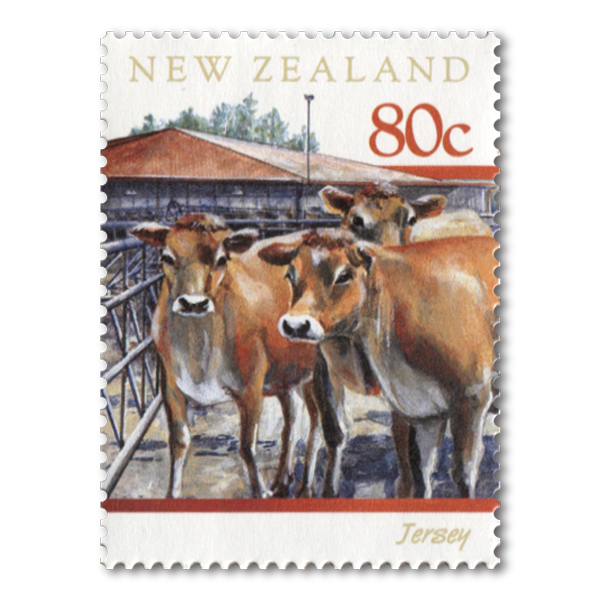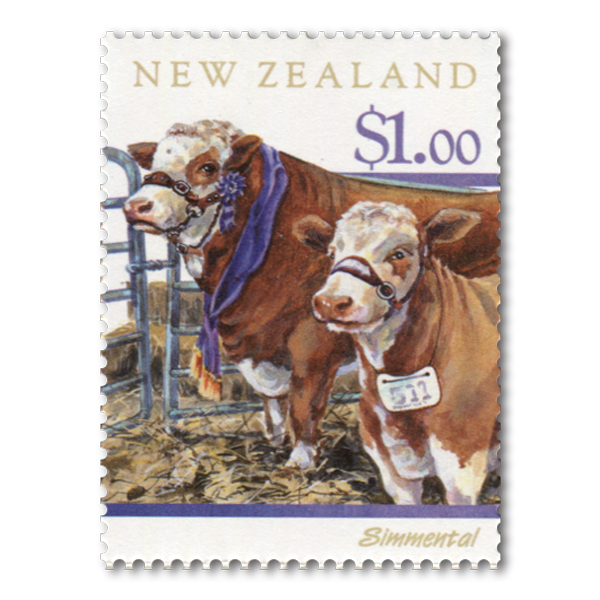Cattle in New Zealand have a long history, both in the beef and dairy industries, dating back to the first arrival of Shorthorn cattle around the time of Reverend Samuel Marsden in 1814.
Issue information
Cattle farming in New Zealand began in 1814 when the Reverend Samuel Marsden landed a bull and two heifers in the Bay of Islands. These early Shorthorns worked with settlers to clear virgin bush, cart supplies, produce milk, butter and cheese and, on the odd occasion, providing meat.
Cattle, for many years, were in a secondary position to the lucrative wool industry in New Zealand. With the advent of refrigerated shipping in the 1880s, the price of a cattle beast rose to more than merely the value of its hide. Export markets opened up at the turn of the twentieth century, and demand grew for improved cattle. The country's cattle herd has grown from these humble beginnings to a combined beef and dairy herd numbering more than 9 million animals.
The breeds featured in this stamp issue have proved to be among the best beef and dairy producers for the New Zealand agricultural industry.
The Cattle of New Zealand stamp issue coincided with the Chinese New Year - the Year of the Ox. To commemorate the Lunar New Year, the stamps were produced with a gutter strip through each sheet which featured a lunar calendar ox.
Product Listing for 1997 Year of the Ox - New Zealand Cattle
| Image | Title | Description | Price |
|---|---|---|---|
 |
Single Stamp |
Single 40c 'Holstein-Friesian' gummed stamp. These cattle were first imported as Dutch Friesian in 1884, and have been infused with American Holstein genes and new bloodlines of Friesian from the United Kingdom and North America. This is the most common breed of dairy cattle in New Zealand, with the highest average milk production of all dairy breeds. The milk generally has a lower fat and protein content. Holstein-Friesians are large cattle that require plenty of feed, and accordingly are suited to flat, quality pasture. |
$0.40 |
 |
Single Stamp |
Single 80c 'Jersey' gummed stamp. This breed was first imported from Jersey, one of the Channel Islands, in 1862. The fine-boned looks and small stature of the Jersey belie the huge potential of the breed for converting green grass into high-fat, protein-rich milk. The fawn-coloured animals with dark faces and muzzles possess curved horns and large dark eyes. The jersey is one of the smallest dairy breeds, and is abundant in Taranaki, one of New Zealand's chief dairy districts. Changes to the dairy cow evaluation system in 1996, run by the Dairy Board's Livestock Improvement Corporation, have highlighted the efficiency of the Jersey breed at converting feed into net profit. Whilst the breed has always been noted for its superior milkfat production and lower milk volume, the recognition of the lower maintenance requirements of the smaller cows has led to an increased interest in the breed. |
$0.80 |
 |
Single Stamp |
Single $1.00 'Simmental' gummed stamp. The Simmental is a relatively new arrival on the New Zealand beef scene, in spite of being one of the world's oldest breeds (and numerically the second largest). Originating in the Simmen Valley in Switzerland, the breed was popular all over Europe for its multi talents of producing beef and dairy products, as well as working as a draught animal. The breed is well muscled with excellent growth rates and lean high-yielding carcasses, and has become popular for cross-breeding in many parts of New Zealand. |
$1.00 |
 |
Single Stamp |
Single $1.20 'Ayrshire' gummed stamp. The Ayrshire was the second breed of cattle to arrive in New Zealand, arriving in 1848 from the Scottish district of Ayr. The cattle are of medium stature and have upwardly curving horns, although it is common practice to dehorn animals when calves. The Ayrshire is found mainly in southern parts of New Zealand, as they are ideally suited to the rigorous, rough county, while being high yielding milk producers. |
$1.20 |
 |
Single Stamp |
Single $1.50 'Angus' gummed stamp. The pure black Angus breed, formerly known as Aberdeen Angus, after the Scottish county from which it originated, was first imported into New Zealand in 1863. The Angus is now the most numerous breed in the national beef herd. This breed enjoys a reputation for producing fine-grained beef, even from hilly country with scant pasture. Development of the breed over the last 30 years has seen an increase in the stature and frame of the cattle, improving the meat-to-bone ratio and decreasing fat cover. |
$1.50 |
 |
Single Stamp |
Single $1.80 'Hereford' gummed stamp. One of the first English breeds to be developed, the Hereford was in much demand from the 17th century onwards as a yoke oxen and for its milk and beef production. Arriving from the Herefordshire region in 1868, the distinctively-coloured deep red cattle with white face, brisket, belly and legs, spread quickly throughout New Zealand. The Hereford is a beef producer that can climb and forage over the rough terrain unsuited to the dairy breeds. |
$1.80 |
 |
First Day Cover | First day cover with stamps affixed. Cancelled on the first day of issue. | $7.20 |
Technical information
| Date of issue: | 15 January 1997 |
|---|---|
| Stamps and first day cover designed by: | Lindy Fisher, Auckland, New Zealand |
| Number of stamps: | Six |
| Denominations and designs: | 40c Holstein-Friesian, 80c Jersey, $1.00 Simmental, $1.20 Ayrshire, $1.50 Angus, $1.80 Hereford |
| Printer and process: | House of Questa, England by lithography |
| Number of colours: | Five |
| Stamp size and format: | 40mm x 30mm (vertical) |
| Number of stamps per sheet: | 100, with a vertical gutter strip of 10 ox logos through middle of sheet |
| Perforation gauge: | 14 |
| Paper type: | 102gsm unmarked red phosphor coated |
| Cost of unaddressed first day cover: | $7.20 |
| Gutter pairs: | Could be obtained by purchasing at least two stamps, with a gutter panel between them |
| Special blocks: | Plate/imprint, positional or value blocks could be obtained by purchasing at least six stamps. |
| Colour blocks: | Also known as 'traffic lights', these blocks were included in plate blocks. |
| Barcode blocks: | Barcode blocks were available in both A and B formats. |
| Period of sale: | These stamps remained on sale until 15 January 1998. |

